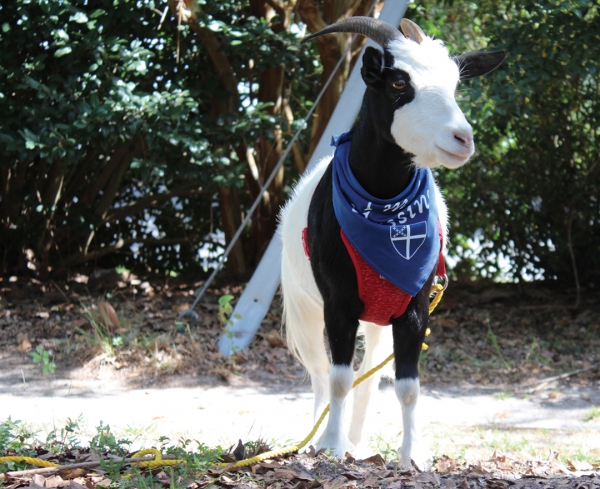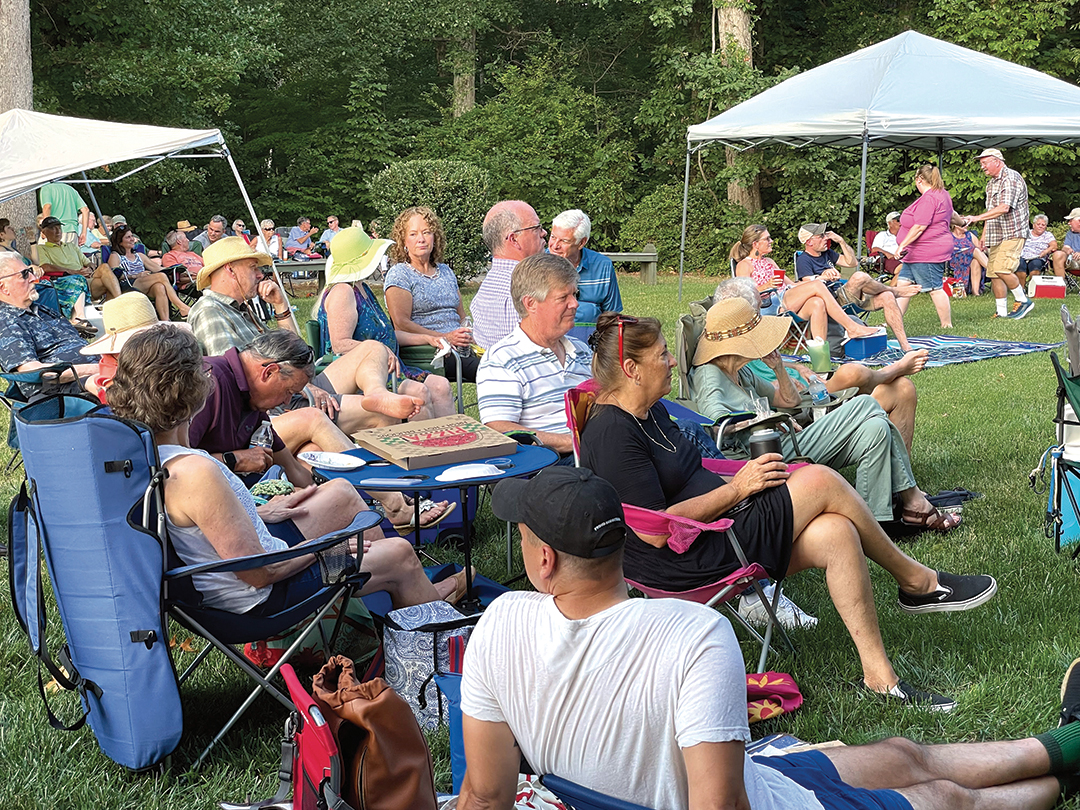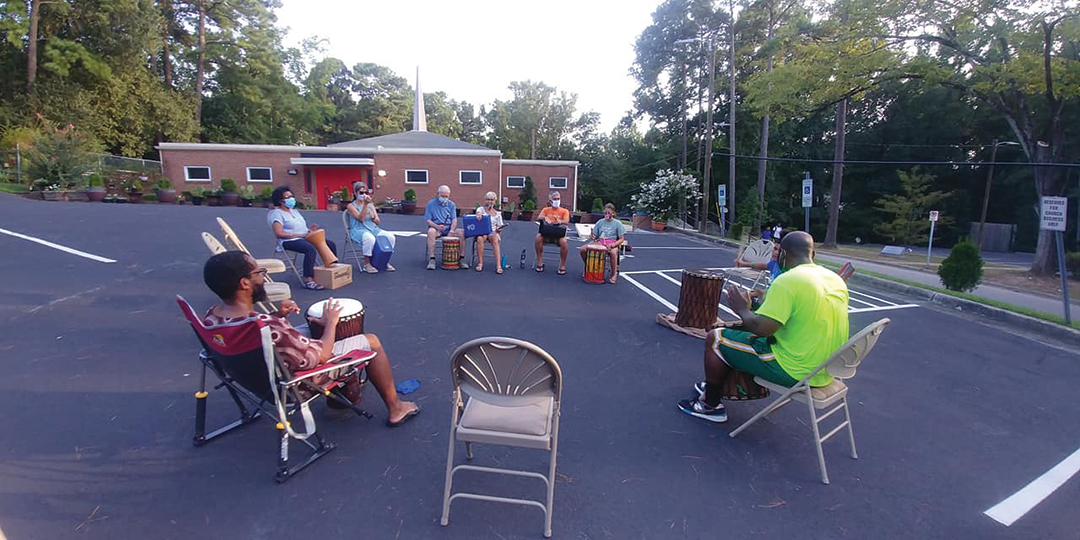Disciple: Being the Church in Community

How congregations are connecting with their neighbors in novel ways
When the vestry of Trinity, Fuquay-Varina, asked Karen Teague to head up the church’s participation in the town’s annual Celebrate Fuquay-Varina Festival during the first weekend in October, she said no. “Let’s do the TryTank experiment instead,” Teague countered, referring to an initiative of the self-described “experimental laboratory” of church innovation aimed at drawing people to church by inviting them to Blessing of the Animals services around St. Francis’ feast day. TryTank’s theory, which also resonated with Teague, was people had relied more heavily on their pets for companionship and support during COVID-19 lockdowns and 18 months of social distancing, and therefore they might be more inclined than ever to celebrate them.
The vestry agreed to join the experiment, and Teague set to work. Partnering with the Rev. Ken Kroohs, TryTank’s experiment lead, Teague recruited a team of 10 dedicated volunteers from Trinity and set to work. They advertised through Nextdoor, paid Facebook ads and fliers posted in local businesses, dog parks and centralized mailboxes in developments, and they invited a variety of vendors to a festival on the church’s property. On a beautiful autumn day, more than 200 people—mostly visitors and young adults—descended upon Trinity’s three acres. Seven vendors, including a mobile veterinary clinic and a pet adoption agency, two food trucks and one saxophonist added to the festive atmosphere. The church had planned only one actual service of Blessing of the Animals, but, as it became clear some people had attended solely for that reason, planners pivoted and held a second, earlier blessing. Trinity’s interim vicar, the Rev. Susan Keedy, roamed the crowd blessing animals between services, trailed by a member of the church’s youth group handing out branded bandanas, provided by TryTank, for pets to wear.
[Image: Panda the fainting goat wears the bandana he received after being blessed at Trinity, Fuquay-Varina, during the Blessing of the Animals festival. Photo courtesy of Trinity]
Consider which events or feasts in the church calendar might have a broader community appeal, like the Feast of St. Francis and related Blessing of the Animals services or Christmas lessons and carols. What is the hook—be it love for pets or enjoyment of music—that might encourage someone who is skeptical about church to visit your campus?
While the event was, according to Teague, the most successful in recent Trinity history, it was only the beginning. TryTank emphasizes intentional follow-up with visitors as part of their experiments, so Trinity invited visitors to fill out cards with their phone number and email address to qualify for a prize drawing. The church collected 115 cards, and additional attendees had preregistered for the drawing via Eventbrite linked to the Facebook advertisements. After adding attendees’ contact information to the church’s database, Trinity sent a short message 36 hours after the event, a link to the event photo album five days after the event and an invitation to submit names of deceased loved ones in advance of All Saints’ Day. Less than a quarter of new contacts unsubscribed after the first message, and the church has plans to remain in relationship with those who attended the festival.
While the idea of a Blessing of the Animals festival might sound novel, in truth it is simply an extension of a theme the Diocese of North Carolina has pursued since the Most Rev. Michael Curry encouraged us to “go to Galilee:” churches no longer can wait for new members to stroll through their doors. Instead, churches must find new ways to offer what is unique about their congregation to their surrounding neighborhoods. This is how we identify partners for collaboration and build new communities, as our current mission strategy describes.
A BLESSING FOR THOSE WHO CANNOT COME TO CHURCH
Examine the annual events your church already hosts, and consider how you might expand the most popular ones into the wider community. Can you relocate the event to a more neutral setting—shifting a concert series outside instead of in the sanctuary, for example—or move it somewhere a population that normally does not or cannot attend the church might have an easier time accessing?
Holy Comforter, Charlotte, also joined the TryTank Blessing of the Animals experiment but took a different tack to deepen a pre-existing relationship with Southminster, a continuing care retirement community where many parishioners reside. The experiment’s purpose was the same—to “deepen the impact and expand the reach of Blessing of the Animals, especially during a pandemic when animals had so clearly become important in new ways to more people,” as experiment co-chair Beth Hardin described it—but the outcome was different. While Holy Comforter was more intentional about inviting people to the church’s on-campus service, which this year featured a photo booth, they also expanded their presence at Southminster by hosting what Hardin believes was the community’s first Blessing of the Animals service. Participants received homemade pet treats baked by a Girl Scout troop and Holy Comforter youth, as well as gift bags with information about Holy Comforter’s regular offerings at Southminster: a monthly Eucharist led by the rector and a parishioner-led bimonthly spiritual meditation practice.
Since the retirement community does not share its residents’ contact information, Holy Comforter could not follow up with those who attended in the same way members of Trinity did after their festival. The church’s openness to a new way of doing things, however, did yield at least one powerful connection. Charlotte Mecklenburg Animal Care and Control was represented at the event with a dog in need of fostering. Hardin’s husband fell in love with and adopted a 14-year-old Labrador retriever named Faith. The adoption packet contained the previous owner’s contact information, so Hardin reached out and learned the couple had surrendered the dog due to the wife’s terminal lung cancer. When Faith took a turn for the worse a few weeks later, the Hardins invited her previous owner to come say goodbye, and, when his wife died shortly after, he invited them to her funeral.
“You never know where these things will take us,” Hardin reflected. “This time, it took us to a historically Black megachurch for a homegoing service.”
THE POWER OF MUSIC

It was from within this culture of music that Charley Patterson began to feel the void in his life left by the suspension of live performances during the initial COVID-19 lockdown in March and April 2020. While taking a walk through his neighborhood, Patterson ran into a musician neighbor and invited him to play on his front porch for the neighborhood. Later, he invited the Sprinkles to play a porch concert, and a neighbor with a new wood-fired pizza restaurant provided free pizzas to everyone who gathered.
[Image: A crowd gathered for the Steppin’ Out concert St. Patrick’s, Morrisville, hosted on August 22. Photo courtesy of St. Patrick’s]
As restrictions started to lift this August, Patterson had the idea to replicate his front porch concerts at St. Patrick’s. A stage behind the church was the perfect spot. “Let’s throw a party,” he recalled saying to the rector, the Rev. Greg McIntyre. On August 22, St. Patrick’s hosted local band Love Not Money for a free community concert. People brought their own chairs and blankets, and Patterson’s pizza-baking neighbor and a hotdog vendor sold concessions. McIntyre, dressed in a baseball cap and shorts—“looking like a normal guy who eats with a knife and a fork,” Patterson said—welcomed everyone to the church. Patterson had done some pre-work, too, contracting a local PR professional to help with advertising.
Many large churches in other denominations are excellent at advertising their events to the broader community. What might your church learn from them about marketing your church? How will you advertise to let the community know an event at your church is open to the public? A farmer’s market might be a great place to advertise an event dedicated to creation care, for example.
Approximately 120-140 people attended the concert, and four of them have since begun attending the church. Two are now pledging members.
“I see music—I see some of the social events that we do—as a great trial [run],” Patterson explained. “If nothing else, it gets them through the door. If nothing else, it allows our existing community—fellow parishioners—to tap a neighbor on the shoulder and say, ‘We’ve got a concert going on. Why don’t you come with me?’”
Sometimes, making connections with neighbors who haven’t attended the church before might take the form of a full-blown festival on church grounds or an outdoor concert. Other times, it might be as simple as taking a walk around the neighborhood.
“How do we remain relevant in a gentrified space? What is the role of St. Titus’ in our community?” These are the questions the Rev. Mawethu Ncaca, curate of St. Titus’, Durham, through the Reimagining Curacies program, posed in a reflection in the October 2021 edition of the church newsletter. The answers Ncaca proposed over the summer were to walk and hang out with the church’s neighbors. Just Walk was a weekly prayer walk around the neighborhood, which allowed members of St. Titus’ to see who their neighbors are and what the neighborhood is like today while re-introducing the church to the community. A small group gathered after the regular Wednesday Evening Prayer service and, quite literally, just walked. They observed their surroundings, chatted with neighbors and offered to pray for people during worship services. It was as easy as that.
The name of the initiative, Just Walk, is both a call for justice in the neighborhood and a nod to the simplicity of the idea. St. Titus’ often helps neighbors pay rent or cover their utility bills, but those they help don’t necessarily connect that aid with the individuals who make up the congregation. Introducing—or re-introducing—the church to the neighborhood is an easy way to make that connection while also assessing the changing demographics around the church.
“We are human beings, and we live in time and space, so space shapes how we think about God and how we see God in different spaces,” Ncaca explained. While St. Titus’ is a historically Black church in a historically Black neighborhood, recent developments near the church are overwhelmingly white. “You remember the history of the place, but also you understand the current situation, and welcome people: ‘Hey, we’ve been here a long time, and maybe you were never welcome in this community, but we welcome you.’”
Convincing a newcomer to attend an event at your church is only the first step. How will you make people feel welcome once they arrive? A public perception that your church is unfriendly or cliquish is worse than no public perception at all. How will you follow up with guests after they’ve enjoyed your church’s hospitality?
The second new initiative, Hanging Out with Neighbors, involved a casual Thursday night djembe drum circle in the church’s parking lot. Elisha Harris, a former neighbor of Ncaca’s who now lives within a block of the church, leads the gathering each week. “We are not the experts, the Church,” Ncaca explained. “We are not there to teach the community; the community must come teach us. That’s the theology that we’re bringing. As the church, we need to be humble, to be taught by people who live around us, instead of us always trying to teach them.” The composition of the drum circle reflects that openness. While Harris supplies a few drums, others bring what they have, whether it’s a percussion instrument or a blue recycling bin. Someone starts a beat, someone else jumps in to build on the rhythm, and music happens in community. Neighbors join the circle because they’ve been invited during the course of a Just Walk, they’ve seen the event advertised on Facebook or they’ve heard the music emanating from the parking lot.
Holy Spirit, Greensboro, is another church that has experienced enormous success by walking through the community surrounding the church and listening to their neighbors’ concerns. In fact, years of hearing repeated prayer requests for health-related issues eventually led to the formation of a health ministry, Abundant Life, based out of the church. (Disciple, Fall 2020, “The Abundance of Community” and Summer 2018, “Know Your Neighbor, Serve Your Neighbor”) While not every attempt at reaching out will yield an entirely new ministry, nothing will happen without taking the first steps, listening and being open to the possibilities. During the restrictions associated with a pandemic, such new possibilities might take the form of pivoting a long-established ministry in an entirely new direction.

[Image: To re-introduce the church to the neighborhood, St. Titus’, Durham, hosted a weekly drum circle in the church parking lot throughout the summer and again during the fall. Photo courtesy of St. Titus’]
DINNER TO GO
Offer to pray for your neighbors. Whether through a prayer walk, a prayer request box or handwritten notes left on people’s porches or doorsteps, ask your neighbors how you can pray for them, and let them know how they can pray for you. How will you let people know the congregation has prayed for them during worship or individually?
The tradition at St. Margaret’s, Waxhaw, is for the men of the parish to cook breakfast for worshipers on Sunday mornings. As COVID-19 guidelines rendered communal meals impossible, they looked for new ways to gather and use their culinary skills for the good of the community. Thus the Community Kitchen Fellowship (CKF) was born. With executive assistant to the rector for outreach and parish connection Traci Scott’s help, the men decided to cook boxed meals for neighbors in need in the Waxhaw and Mineral Springs areas. While some of the men gather in St. Margaret’s kitchen to cook, a second team delivers meals to neighbors in need—literally driving out into the neighborhood to connect with community members.
The first meal, cooked and delivered in October, served 67 neighbors in 32 homes. The overwhelmingly positive feedback has encouraged the group to continue the ministry on a monthly basis, supplementing the hot meals with themed groceries around major holidays like Christmas and Easter.
The energy generated by a congregation reaching out to its neighbors in creative, low-pressure ways leads to more ideas and a greater level of comfort engaging with people in their spaces and on their terms. The opportunities to deepen relationships begun in this way are vast. Trinity, for example, plans to invite those neighbors with whom they’ve been texting since the Blessing of the Animals festival to an informal, outdoor Christmas Eve service with fire pits, spiced cider and, of course, a reminder the church is there to preach and teach the Good News.
Summerlee Walter is the communications coordinator for the Diocese of North Carolina.
